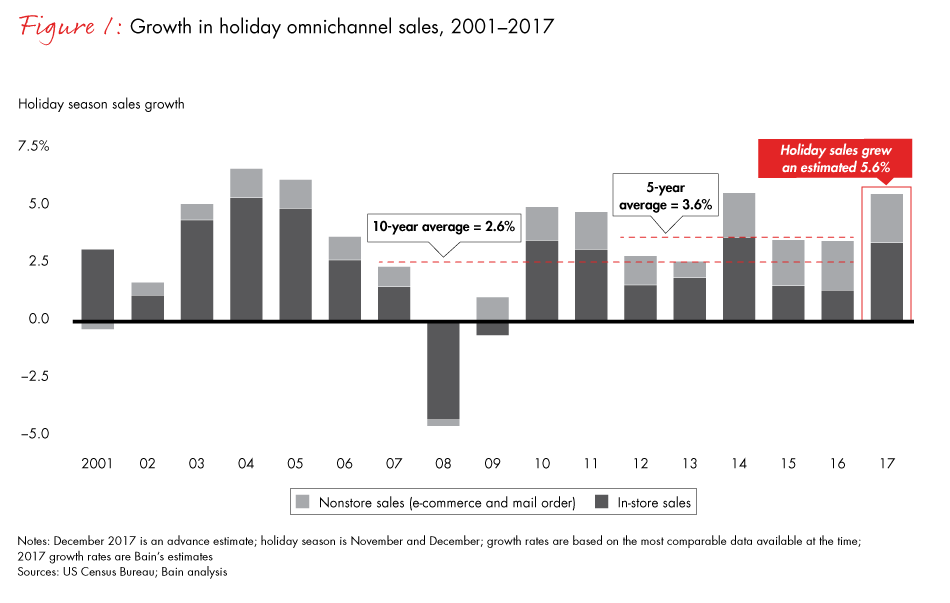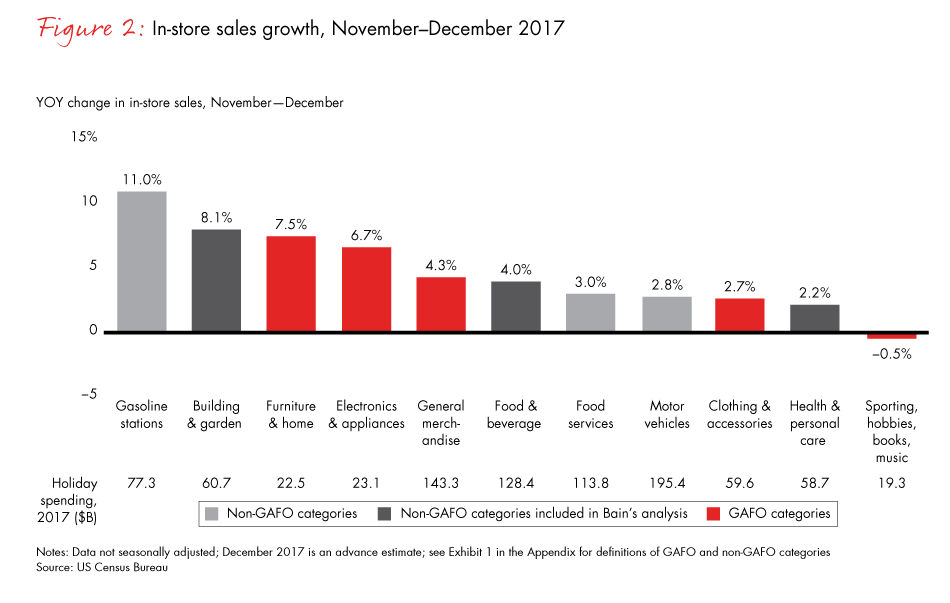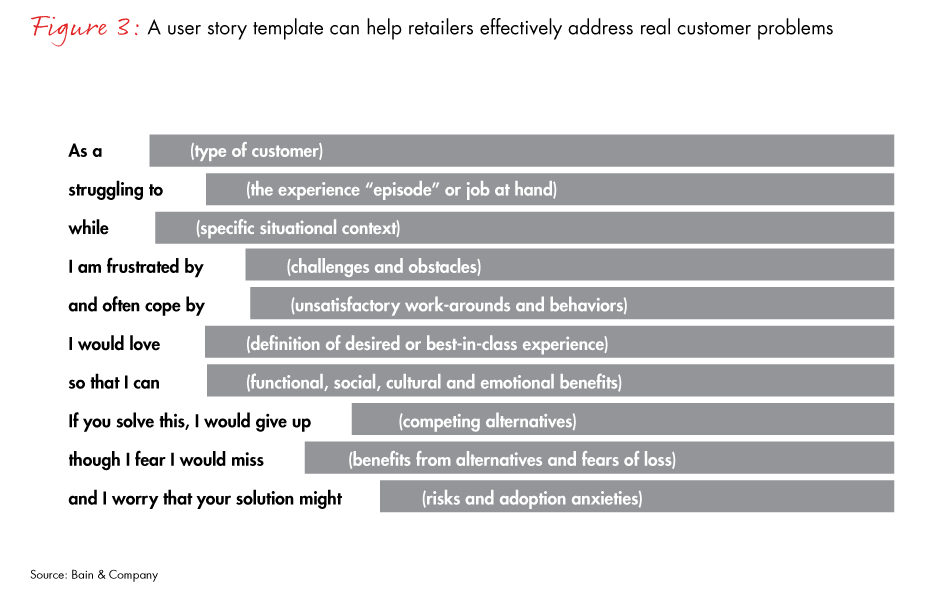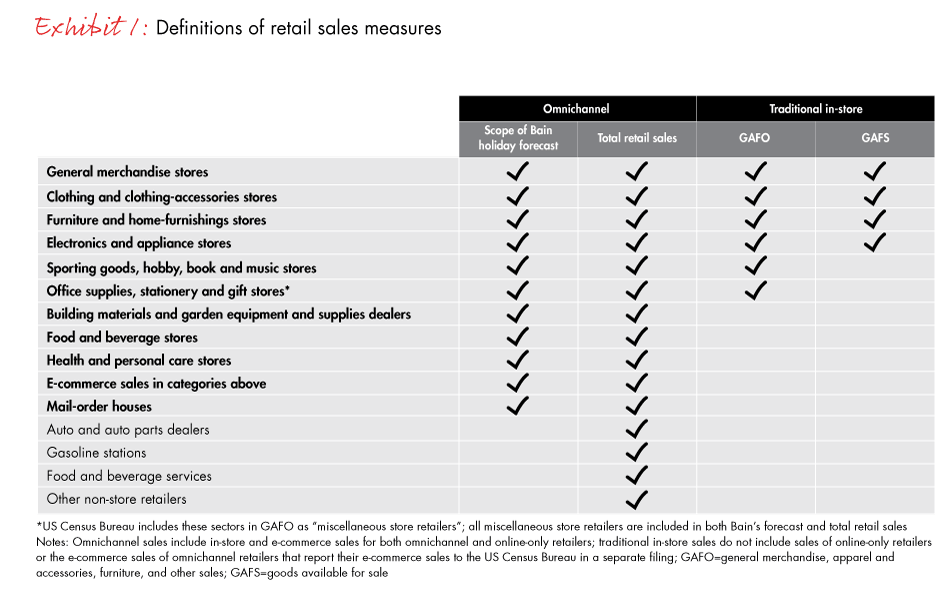Brief

Retail sales this holiday season rose an impressive 5.6%, far above most predictions. The biggest surprise came from in-store sales. They grew at 4.3%, more than 2 percentage points higher than last year. E-commerce was also strong, with sales through mobile devices and on Amazon.com driving much of the growth. And there was more good news: lower tax rates on income and foreign-cash repatriation. What should retailers do with the funds produced by record sales and tax breaks? Don’t be complacent. Instead, invest to turn short-term gifts into sustainable trends. In this issue, we share six resolutions for how retailers can carry their momentum into 2018 and beyond.
Recapping an exceptional holiday season
This season was truly a gift to many retailers. As consumers joyfully unwrapped new sweaters, home goods and high-end smartphones, many retailers were also celebrating. Preliminary estimates indicate that Bain-defined retail sales (see Exhibit 1 in the Appendix) grew at an impressive 5.6% this holiday season, the highest growth rate since 2014 (see Figure 1). E-commerce saw robust double-digit growth again this year. But the real surprise was in-store sales. In-store sales—which account for more than 80% of total sales—had an unexpectedly strong season, up more than 2 percentage points over last year.
In fairness, as more and more purchases are made through multiple channels, it’s increasingly difficult to classify sales as “in-store” or “e-commerce.” For example, how do you categorize the sale of a jacket discovered on a website, researched on a mobile app and then purchased or picked up in a store? Conventional ways of classifying sales don’t account for this complexity, and sales estimates vary depending on how sales are categorized. Acknowledging this classification problem, here are our best estimates of how this season’s sales broke down across channels.

In-store sales saw unexpected growth
Recently released Census Bureau data suggests that in-store holiday sales grew 4.3% over last year, the highest growth rate since 2014. Building materials grew by 8.1%, while furniture and home furnishings grew by 7.5%—in part a function of rebuilding efforts in the wake of hurricanes and fires. General merchandise stores, the largest category by sales (excluding motor vehicles and parts), grew by 4.3%. Sporting goods, hobby, book and music stores, the only category that saw negative growth, fell by just 0.5% (see Figure 2).

Several factors contributed to the surprising jump in in-store sales. In partnership with Earnest Research, we found that the average in-store basket size increased 2% year over year, likely driven by increases in both price and quantity. Weather, which is often blamed for poor sales, may actually deserve some credit this year. Dry weather on key shopping days made it easier for people to get to stores, and cooler weather boosted sales of winter gear—which didn’t move as well in the warmer 2015 and 2016 holiday seasons. Another factor that may have contributed to in-store sales growth is the increase in omnichannel options, among them “buy online, pick up in store” (BOPIS), “find in store” and “reserve in store.” For example, Costco started offering BOPIS for select items this winter and reported that half of its BOPIS customers stayed to shop for other items in the store. Lowe’s, Target, JCPenney, Best Buy and The Home Depot also offer BOPIS, with some reporting that between 20% and 40% of shoppers who pick up in stores end up buying more items. Both American Eagle Outfitters (“Reserve, Try & Buy”) and Nordstrom (“Reserve Online & Try In Store”) offer services similar to BOPIS, encouraging customers to reserve items online and then come to a store to try them on. Nordstrom reports that 80% of shoppers who try the service use it multiple times. One reason in-store pickup has seen success is that it helps shoppers avoid the recent rash of porch thefts. Nearly a third of Americans say they’ve had a package stolen from their doorstep.
E-commerce sales remain strong
The Census Bureau doesn’t release advance estimates for e-commerce sales, and third-party estimates vary widely given different methodologies. The broader range for e-commerce growth this season is 10% to 18%. We estimate that it will end up in the mid-teens. These rates likely underestimate the influence of e-commerce on total sales. According to Forrester Research, 44% of 2017 offline sales across 30 top retail categories were “digital-influenced sales”—sales to consumers who research their purchases online but buy in stores.
Mobile websites and apps were the stars of e-commerce growth, with consumers shopping more and more on smartphones and tablets. According to Adobe, sales on mobile websites grew 28% over last year and accounted for 33% of online sales in November and December. Mobile app usage also went up. In partnership with SimilarWeb, we looked at Android app usage across the top 40 retailers. This holiday season, daily active users grew by 62% over last year, and the average time spent on an app increased by 4 minutes (15 minutes versus 11 minutes). That extra time was not necessarily spent shopping. Many retailers are successfully using mobile apps to improve customers’ overall experience. For example, this holiday season Target added a mobile payment feature to its app that allows shoppers to check out up to four times faster than if they were using alternative forms of payment. And in November, Walmart introduced Mobile Express Returns, a system that lets Walmart.com customers return items in stores in two simple steps: First they choose the items they want to return using the Walmart app to get a quick response (QR) code, and then they use the expedited Mobile Express Lane at the customer service desk to scan the code and return the items.
Amazon also played a key role in the growth of e-commerce this holiday season. It accounted for roughly 50% of online holiday sales—up from 39% last year—and saw the number of purchases on its app grow by nearly 70%. In one holiday week alone, more than 4 million people started Prime free trials or paid memberships. According to GBH Insights estimates, average Prime subscribers spent 22% more on Amazon this holiday season than they did last year. And on Christmas Day, Amazon’s Alexa app was the most downloaded app on both Android and iOS. Amazon not only saw more activity, it appeared to handle the rise in sales, Prime members and Alexa users quite well: The company’s Net Promoter Score® (NPS®) this past December was 46 points versus 41 points for its online competitors, according to Bain’s 2017 Holiday Shopper Pulse survey conducted in partnership with Research Now.1 While Amazon outperforms others on NPS, the gap between it and other online retailers has shrunk. There was a difference of 11 points in December 2016.
Looking ahead to 2018: New Year’s resolutions
At first glance this holiday season seemed to mark the end of troubled times for retailers. In addition to strong sales, they received a tax break that analysts estimate could drop effective tax rates by 10% to 15% on average. The question retailers have to ask: What can we do to take the gift of this strong season and make it last? Our answer: Use it to create a differentiated omnichannel customer experience.
The double-digit growth of online sales this season, combined with the remarkable success of physical stores, reinforces our thinking that being omnichannel—and getting it right—is critical. After all, retailers’ best customers are shopping across channels, and they’re spending twice as much as single-channel shoppers. We know this isn’t breaking news, and most retailers have already introduced some form of multichannel retailing. In addition, Bain research shows that more than 70% of top retailers have pegged seamless omnichannel customer experiences as a corporate priority. The catch is that although most retailers get a few pieces right, few deliver great end-to-end shopping experiences. As we head into 2018, we propose six resolutions retailers can act on to delight their customers.
Resolution #1: “Don’t be an idiot”—change the game
In an episode of the popular TV series The Office, Regional Manager Michael Scott asks one of his highest-ranking salesmen, Dwight Schrute, “What was the most inspiring thing I’ve ever said to you?” Dwight’s response: “‘Don’t be an idiot.’ Changed my life. Whenever I’m about to do something, I think, ‘Would an idiot do that?’ And if they would, I do not do that thing.” We heartily endorse that advice.
According to Amazon CEO Jeff Bezos, the experimentation that leads to change takes time: “If everything you do needs to work on a three-year time horizon, then you’re competing against a lot of people. But if you’re willing to invest on a seven-year time horizon, you’re now competing against a fraction of those people, because very few companies are willing to do that. Just by lengthening the time horizon, you can engage in endeavors that you could never otherwise pursue. At Amazon we like things to work in five to seven years. We’re willing to plant seeds, let them grow—and we’re very stubborn. We say we’re stubborn on vision and flexible on details.”
Although many retailers would describe Amazon as their greatest threat, most continue to battle the online giant with incremental short-term thinking. If we’ve been driving sales through promotions, and we need more sales, it seems logical to add more promotions. If emails are improving sales, then the best way to hit a 5% higher sales target is probably to send out 5% more emails. If the solution to meeting budget cuts has always been to pull labor out of stores, and we need more money, it’s time for layoffs. Too many retailers solve problems by turning to familiar solutions that meet immediate goals but ignore breakthroughs that could change the long-term game. There seems to be no perfect time for launching breakthrough initiatives. In good times, everything is fine, and nobody sees the need for radical change. In bad times, there’s no money or tolerance for risk, so nobody wants to invest in anything other than quick fixes with in-year paybacks. That’s why we’re suggesting that now is the perfect time to commit to change.
We also believe that if insanity is doing the same thing over and over again and expecting a different result, there’s a lot of insanity in retail. Change is critical to the long-term success of any business. As soon as possible, launch and sustain something that could make a major difference in five to seven years. Think from the future back, not the present forward. Start with hypotheses about customer, competitor and capability trends that will almost certainly be true even if the opportunities to capitalize on them aren’t currently clear. Budget wisely. Don’t spend so much that an initiative is doomed to be killed in the next downturn. And plan to adapt. After all, two-thirds of successful innovations morph significantly from their original concept.
Resolution #2: Give investors, employees and customers beacons of hope
News of store closings and the ongoing decline of once-prominent powerhouses like Sears, Kmart and Toys “R” Us has many wondering for whom the bell tolls next. The burden of proof is now on retailers to show skeptical investors, employees and customers that the future is bright. Yes, retailers are launching many initiatives and then touting the ones that seem to produce positive results. But they aren’t addressing the fundamental question: Will these initiatives help us thrive in today’s tumultuous retail market?
Thomas Edison is probably most famous for inventing the electric light bulb. The only problem: He didn’t. In 1802 Humphry Davy invented the first electric light, known as an arc lamp. In 1854 Heinrich Gӧbel invented the first true light bulb. Yet nothing proved even remotely practical for home use until 1879, when Edison developed the first commercially viable light bulb. He initially struggled to patent it because it was already patented in the United States and the United Kingdom. But over the next couple of years he “innovated” an entire electric light system in lower Manhattan that included his durable light bulb, the parallel circuit, an underground conductor network, devices for maintaining constant voltage, safety fuses and insulating materials, and light sockets with on-off switches. It worked and was rolled out to other locations. This venture would evolve into General Electric.
Instead of implementing individual initiatives, retailers should resolve, like Edison, to create integrated solutions. Take a part of the business—perhaps a district or a banner—and create within it a complete system that clearly wows investors, employees and customers. If you can do that, you can roll it out across the nation or even around the world. If you can’t do that, you don’t have a viable vision. Don’t hide behind disjointed initiatives to pretend that you’re making progress. Go back to the drawing board.
Resolution #3: Improve products, products, products … and services
Nearly every merchant or designer will tell you that the three keys to success are product, product, product. Most customers will tell you that their biggest disappointments with retailers are product, product, product … and services.
Without regular infusions of energy, merchant and design organizations tend to gradually lose their momentum. Merchandise slides from being compelling to being safe. Private brands slip from being profitable and powerful sources of differentiation to being low-cost commodities. With less pressure to inspire, designers recycle signature styles. Retailers opt to do business with fewer and larger vendors rather than the smaller startups that are stealing their market share. Even when teams take a chance on exciting new products, they seldom follow through with displays and services to help customers find and fully appreciate those products.
What can you do? Resolve to return product to its preeminent status, and then strengthen services to magnify its value. Infuse the energy and resources to attract and motivate merchants to spend more time on merchandising activities. Let designers design. Find niche brands or exclusive assortments with a wow factor. Use storytelling to help customers appreciate the full value of your product. Make finding the right product as convenient and emotionally fulfilling as possible. And surround the product with services that competitors are unwilling or unable to match.
Resolution #4: Improve customer experiences where they matter most
More than ever, customers have voice (and video) outlets to express their opinions—and audiences that seem to listen. A short scroll through Instagram or Yelp or OpenTable or TripAdvisor offers a glimpse into the power of advocacy. Get an experience right? The benefits multiply. Disappoint a customer? You’re likely to trigger an angry tweet or a negative review. Plus, thanks to the Internet and cross-border trade, customers have plenty of options to shop elsewhere. For today’s retailers, getting the customer experience right is a must.
Start this year by identifying your best customers—the people you want to work tirelessly to serve better than anyone else. Then pinpoint how you’re going to serve them better: Is it by being cheaper, faster or more convenient? Is it by offering higher-quality goods? Notice that this isn’t a simple segmentation or benchmarking exercise. This is about understanding customers better than they understand themselves and identifying the key moments in the shopping journey that matter most to them. Traditional surveys and ethnographic approaches are helpful, but retail leaders create systems to gather, monitor and act on shoppers’ behaviors. They study social media to identify the experiences customers are talking about most. They tap store managers and associates for a frontline pulse. They don’t always like what they hear, but they take negative feedback as inspiration to do better. And they turn that feedback and those observations about customers’ behaviors into specific user stories (see Figure 3) to be sure they’re addressing real customer problems effectively.

Once leaders identify the most important experiences, they work to understand the business processes that underlie them … something easier said than done. A case in point: If asked, “Who owns the ‘customer checkout’ experience?” many retailers would say, “Well, it’s complicated.” Why? Because every time a shopper checks out, multiple functional silos are involved: stores, e-commerce, credit card services, marketing and technology—to name just a few. Winners work across the silos. For example, they assign accountability for making “customer checkout” a great experience through all channels, assigning clear ownership for the experience and empowering cross-functional Agile teams to break down silos and simplify, expedite and add security to this important experience. This is an iterative process. Winners roll out fixes to their best customers’ biggest problems, but they don’t stop there. They quickly move on and tackle their customers’ next biggest frustration.
Resolution #5: Unleash wasted talent
Retailers are no longer competing only with other retailers for top talent. Instead, employees weigh retail jobs against tech startups, the option to launch their own businesses and much more. Who wants to work 10 layers below a retail CEO on projects that barely cause a ripple in the company when they could help build autonomous electric cars, colonize Mars or solve water shortages? Although employees care more about salary than any other aspect of a job, no retailer can afford to win over talent by simply paying more. What can retailers do? Give top talent more responsibility, and empower employees by removing hierarchical layers.
Contrary to popular belief, top organizations don’t succeed because they have significantly more top talent. Bain research shows that the best organizations only have marginally more star players (16% of their employees versus 14% for other companies), but they use them more effectively and productively. They identify their stars and let them tackle the thorniest questions: How can we improve important customer experiences? What do we need to do to develop more radical innovations over the long term? The best retailers also build a culture that supports organizational success—perhaps by creating clear decision roles or by prioritizing professional and personal development or by giving employees a strong sense of purpose. These efforts have impressive results: Bain research shows that companies that make good use of their top talent are 25% more productive than those that don’t.
Retailers’ tendency toward hierarchy and rigid chains of command creates challenges. A recent Bain survey of nearly 1,300 global executives found that more respondents agreed with one statement about management than any other: “Today’s business leaders must trust and empower people, not command and control them.” Only 5% of the sample disagreed. Retailers can look to changes—removing layers of middle management, for instance—that expand control and do away with micromanagement. These changes empower employees, encourage them to stick around longer and make positions more attractive to future hires.
Resolution #6: “Zero-base” to fuel growth and innovation
Following through on most of these resolutions takes money, and, unlike Amazon, most retailers struggle to defer earnings over long periods of time. Finding the funds to fuel innovation is a problem. For most retailers it means stripping out waste and improving productivity. There are a number of solutions. Activist investors tout zero-based budgeting (ZBB), a blank-slate approach that dissects, categorizes and analyzes all costs into “cost packets.” The process helps retailers get a full understanding of their costs, including the underlying drivers of spending by cost category, which allows them to apply a level of scrutiny to operating expenses that is comparable to what they typically apply to capital expenditures. Plus, ongoing co-ownership of those packets with clearly linked incentives to stay within budgets helps deter costs from creeping back into the system after the initial effort. The results can be impressive. For example, one consumer products company saw quarterly sales and general and administrative expenses drop by 12.8% in 2016 compared to 2015. The company expects a total savings of $1.7 billion from its cost-saving initiatives.
The problem? ZBB can interfere with innovation and growth. Too often, ZBB leaves companies doing many of the same things with fewer resources and little to invest in growth. In Bain’s experience an important but often overlooked ingredient of ZBB is zero-based redesign (ZBR). ZBR is about simplifying the organization by realigning the business and reengineering the work. It considers which activities should be kept and how activities should be performed, deploying the latest technology and analytic solutions to speed up and improve decisions. Retailers can identify unnecessary business, process or organizational complexities—for example, service offerings that customers don’t care about, drawn-out approval times for urgent decisions or too many people working on a task. Then they can define and implement new ways of working to reduce both costs and complexity.
…
While pundits warn of a retail apocalypse, and several retailers will certainly learn about Darwinism the hard way, we believe those that survive and thrive will prioritize two simple strategies. First, keep customers front and center in your decision making. And second, as you make decisions, commit to changes that will matter over the next five to seven years.
This is the last issue of this season’s holiday newsletters. We hope you’ve enjoyed our discussions of Amazon, technology in retail, seasonal promotions and omnichannel customer experiences. To read the full series, please visit www.bain.com/holiday. We look forward to keeping in touch with you over the course of the year, and we will be back this fall to share our 2018 holiday outlook. All the best for a happy and prosperous New Year!
Appendix

About Our Research Partners
Earnest Research, a data innovation company, offers market and consumer research products derived from the transaction data of millions of anonymous US-based consumers to support consultants, investors and corporate clients. Leveraging a proprietary full-digital-wallet methodology and longitudinal cohorting, Earnest Research provides insight into consumer behavior trends and an unbiased look into competitive market dynamics with a high degree of accuracy against company-reported metrics. For details, visit https://earnestresearch.com or contact Elina Baygildina (ebaygildina@earnestresearch.com).
Research Now is a global leader in digital research data for better insights and business decisions. Founded in 1999, the company was a pioneer in originating online data sampling. The company provides research data solutions for its 3,000 market research, consulting, media and corporate clients through access to more than 11 million deeply profiled business professionals and consumers. Research Now currently operates in more than 40 countries around the globe with locations in the Americas, Europe, the Middle East and Asia-Pacific. For more information, please go to www.researchnow.com.
SimilarWeb is a pioneer of market intelligence, providing granular insights about any website or app across all industries in every region to help brands improve their decision making and win market share. The solution is used across organizations and industries to understand industry dynamics, reveal competitors’ strategies, benchmark performance and identify new opportunities in marketing, sales, strategy, business development, investments and more. SimilarWeb has raised over $112 million and has nearly 400 employees across eight global offices. Learn more at www.similarweb.com.
1 The Net Promoter Score® is derived by asking consumers, “On a scale of zero to 10, how likely would you be to recommend this company (or this product) to friends and colleagues?” Ratings of 9 or 10 indicate promoters; 7 and 8, passives; and zero through 6, detractors. The score is simply the percentage of promoters minus the percentage of detractors. Net Promoter®, Net Promoter System®, Net Promoter Score® and NPS® are registered trademarks of Bain & Company, Inc., Fred Reichheld and Satmetrix Systems, Inc.



